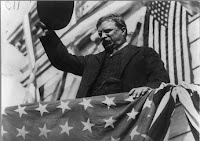Assignment 4: You’re the Playwright
Experiment with the playwright’s craft by writing the first page or two of an original play. When you’re done you’ll have a title, a list of characters (with descriptions), information about the set and stage directions, and dialogue between two characters. This assignment isn’t nearly as intimidating as it sounds! Just launch in, and see what happens.
These rules will make your job easier:
- Limit the time covered to one small unit. (ex: an hour, a car-ride home from the airport, a class period, etc.)
- Do not change the setting. (ex: all action happens at the dinner table, inside a car, etc.)
- Keep the action moving forward (no flashbacks) and
- Just let the dialogue lead you through the scene.
Choose one of the following ideas, OR invent your own:
- two students who both want the same thing
- a coach and a player in conflict over steroid use
- two friends, one of whom has been engaged in some risky activity
- a parent and daughter/son in conflict over values, money, future plans
- a thief or other criminal and his/her victim
- the drivers of two cars, after one has smashed into another
- a soldier returning from Iraq and an anti-war protester
- two people with differing opinions on a controversial political issue
A standard rubric will be used for grading. Not many of us are born to be playwrights, so making a good effort is the most important route to a good grade on this project.
Here's my attempt:
The Shopper
This play involves a coincidental meeting of strangers…who have something in common.
CHARACTERS:
Natalia: a Russian-American teenager living in San Francisco. Everything about her conveys confidence, happiness, excitement. She’s dressed in a micro-mini and red leather jacket.
Sasha: another Russian-American teenager, same age as Natalia. Sasha seems much less confident than Natalia. She is wearing baggy jeans and a jacket that looks like it came from the Goodwill.
SET: The women’s dressing room of T.J. Maxx department store. Natalia is occupying one curtained dressing room and Sasha is in the space next to her. The audience can see into each of the side-by-side spaces where Natalia has brought in piles of bright clothing and Sasha has one or two simple items. The girls can hear each other, but they can’t see each other. It’s obvious from the beginning that the two girls are strangers.
_________________________________________________________
Natalia: (entering the curtained cubicle, humming, placing clothes on a hook. She is obviously happy, and is talking to herself unaware that someone in the next stall can hear her. Her English is great, but she speaks with a strong accent.)
Going to look SOOOO good! Which to try on first…the little sparkling tee shirt? The layers of skirt! (suddenly change and credit cards spill out of Natalia’s bag, scattering everywhere, including into the next curtained booth.)
NO! Oops! There goes my moneys!
(The audience can see Sasha from the front of the dressing stall, but only Sasha’s feet are visible to Natalia. She also speaks in accented English but her voice is much quieter than Natalia’s.)
Sasha: Here, I help you! Here some dollabills! Some credit card coming back your way! (Sasha is now smiling, thinking she has finally made a new friend. She shoves the money back under the curtain in the direction of Natalia . They’re both laughing now.)
Natalia: (loudly, confidently) Spaciba! Thank so much!
Sasha: (still talking quietly through the stall) You going to weekend party?
Natalia: First date with new guy! He just ask me out! Marko his name.
Sasha: (after a very long silence) Marko??
Writing the first pages of a play was a really challenge for me; it's not something I've ever tried to do before. The trick for me was to just sitdown and start writing. I didn't have a story in mind when I began; I just started a dialogue and let it shape itself, line by line. It also helped me to keep it uncomplicated, with only two characters and the TJ Maxx dressing room as a setting.


















